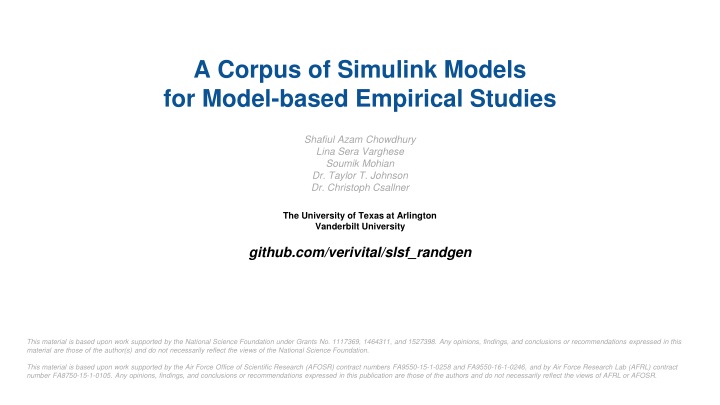
Simulink Models Corpus for Model-Based Empirical Studies
Explore a comprehensive corpus of Simulink models designed for model-based empirical studies in software engineering research. This collection offers insights into model properties, structural metrics, and complexity analysis, supporting future empirical research endeavors.
Download Presentation

Please find below an Image/Link to download the presentation.
The content on the website is provided AS IS for your information and personal use only. It may not be sold, licensed, or shared on other websites without obtaining consent from the author. If you encounter any issues during the download, it is possible that the publisher has removed the file from their server.
You are allowed to download the files provided on this website for personal or commercial use, subject to the condition that they are used lawfully. All files are the property of their respective owners.
The content on the website is provided AS IS for your information and personal use only. It may not be sold, licensed, or shared on other websites without obtaining consent from the author.
E N D
Presentation Transcript
A Corpus of Simulink Models for Model-based Empirical Studies Shafiul Azam Chowdhury Lina Sera Varghese Soumik Mohian Dr. Taylor T. Johnson Dr. Christoph Csallner The University of Texas at Arlington Vanderbilt University github.com/verivital/slsf_randgen This material is based upon work supported by the National Science Foundation under Grants No. 1117369, 1464311, and 1527398. Any opinions, findings, and conclusions or recommendations expressed in this material are those of the author(s) and do not necessarily reflect the views of the National Science Foundation. This material is based upon work supported by the Air Force Office of Scientific Research (AFOSR) contract numbers FA9550-15-1-0258 and FA9550-16-1-0246, and by Air Force Research Lab (AFRL) contract number FA8750-15-1-0105. Any opinions, findings, and conclusions or recommendations expressed in this publication are those of the authors and do not necessarily reflect the views of AFRL or AFOSR.
Motivation Model-based design Increased use of CPS (e.g. Simulink) models Increased interest in model-based empirical studies Understanding model properties and software engineering research Large-scale corpus of Simulink models Unavailable: Studies use handful of (possibly proprietary) models Adversely affects evaluation and replication of studies Model collection: nontrivial overhead 1
Contributions Largest corpus (to date) of ~1k publicly available Simulink Models Corpus design choice Models and their meta information: freely available Study of Model Metrics Structural properties and Complexity Metrics Lightweight Evaluation Tool for metrics study: freely available Can benefit all future model-based empirical research 2
Background: CPS Model Block: Node, basic component of CPS model, represents a formula / code Connection: Edge between blocks Block library: Similar to a standard library of traditional programming language Custom Blocks: Native code using s-functions Hierarchy: block representing a child model Model References and Subsystems 3
Corpus Design Choice CPS Domain From author-provided description and tags Trivial Models Manually identified Model Sources MathWorks tutorial models Public Repositories: MathWorks FileExchange, GitHub, and SourceForge Academic and Search Engine results 4
Design Choice Content Type Only include projects with .mdl and .slx files Keep other artifacts in the project Test Harness and Libraries Keep, identify and publish Toolbox Requirement Mandatory and optional requirements 5
M: Cm: # models # models compiled with University license # models with hierarchy B: C: # blocks # connections H: 7
Blocks Unique Blocks Connections (excluding hidden) Connections (including hidden) Tool 1: sldiagnostics Tool 2: https://blogs.mathworks.com/simulink/2009/08/11/how-many-blocks-are-in-that-model/ 8
Cyclomatic Complexity # Subsystems + Model Reference Strongly Connected Components # Subsystems n: # of decision points o: # of possible outcomes ? ?? 1 ?=1 9
Ext: PIL: Acc: External Mode Processor in the loop Accelerator Mode Fixed: Var: Nor: Fixed-step solver Variable-step solver Normal Mode 10
Pairwise Correlation Analysis of Metrics Kendal s ?; (to compare with Olszewska et al. 2016) Cyclomatic complexity Number of blocks and connections Number of child-model blocks Number of subsystems (0.5297 with cyclomatic complexity) Maximum hierarchy depth (0.5509 with cyclomatic complexity) Compilation time Number of strongly connected components 11
Conclusions We present the largest corpus of public Simulink models Explored interesting model properties and complexity metrics Previously unknown findings in modeling practices Benefits future model-based research Reducing model-collection overhead Aiding evaluation, replication and comparison of studies 12
Corpus Available: github.com/verivital/slsf_randgen 13
Thank You! 14






















